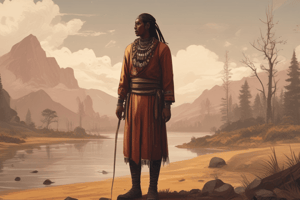Podcast
Questions and Answers
Which of the following best describes the role of western medicine within the historical context of colonization?
Which of the following best describes the role of western medicine within the historical context of colonization?
- It aimed to integrate traditional Indigenous healing practices with modern medical techniques for holistic healthcare solutions.
- It was viewed by colonizers as a means to maintain a healthy workforce and settlement, underpinned by a belief in the superiority of Western practices. (correct)
- It was a neutral endeavor focused solely on improving the health outcomes of colonized populations without ulterior motives.
- It primarily served as a tool for cultural exchange and mutual understanding between colonizers and Indigenous populations.
What was the primary, stated objective of the Canadian Residential School System?
What was the primary, stated objective of the Canadian Residential School System?
- To provide Indigenous children with a superior education that blended Indigenous knowledge with Western academic standards.
- To assimilate Indigenous children into the dominant culture by separating them from their families, traditions, and cultures. (correct)
- To offer specialized vocational training to Indigenous children, preparing them for employment in a modern economy.
- To foster cultural exchange and understanding between Indigenous and non-Indigenous communities.
How did the historical policy of land appropriation impact the health and well-being of Indigenous communities?
How did the historical policy of land appropriation impact the health and well-being of Indigenous communities?
- It maintained traditional lifestyles and diets while providing access to modern amenities.
- It strengthened community bonds and cultural practices through shared resources and communal living arrangements.
- It led to the loss of livelihoods, traditional ways of life, and contributed to negative health outcomes. (correct)
- It fostered economic prosperity and improved living conditions due to infrastructure development.
Which health concern is MOST directly associated with changes to traditional Indigenous lifestyles and diets resulting from colonization?
Which health concern is MOST directly associated with changes to traditional Indigenous lifestyles and diets resulting from colonization?
How do stereotypes within the healthcare system affect the care received by Indigenous patients?
How do stereotypes within the healthcare system affect the care received by Indigenous patients?
What is the role of 'self-determination' as a distal determinant of health for Indigenous Peoples?
What is the role of 'self-determination' as a distal determinant of health for Indigenous Peoples?
Which of the following is an example of an intermediate determinant of Indigenous Peoples' health?
Which of the following is an example of an intermediate determinant of Indigenous Peoples' health?
How might limited opportunities for higher education in remote Indigenous communities affect the population's overall health?
How might limited opportunities for higher education in remote Indigenous communities affect the population's overall health?
What is a key challenge faced by reserve communities that impacts their ability to address social determinants of health?
What is a key challenge faced by reserve communities that impacts their ability to address social determinants of health?
How does a lack of access to traditional foods affect Indigenous people residing in urban communities?
How does a lack of access to traditional foods affect Indigenous people residing in urban communities?
What is the overarching goal of reconciliation between Indigenous and non-Indigenous Peoples in Canada?
What is the overarching goal of reconciliation between Indigenous and non-Indigenous Peoples in Canada?
What was the significance of the 2008 formal apology from the federal government regarding the residential school system?
What was the significance of the 2008 formal apology from the federal government regarding the residential school system?
What crucial undertaking was launched by the Canadian government in 2019 concerning Indigenous women and girls?
What crucial undertaking was launched by the Canadian government in 2019 concerning Indigenous women and girls?
What is the appropriate protocol for interacting with Indigenous Elders when seeking to learn from them?
What is the appropriate protocol for interacting with Indigenous Elders when seeking to learn from them?
What is typically required when asking an Indigenous community to participate in an event or project?
What is typically required when asking an Indigenous community to participate in an event or project?
How does the concept of 'web of being' relate to Indigenous Peoples' well-being?
How does the concept of 'web of being' relate to Indigenous Peoples' well-being?
What characterizes distal determinants of health within the 'web of being' model for Indigenous populations?
What characterizes distal determinants of health within the 'web of being' model for Indigenous populations?
Which of the following is an example of a proximal determinant of health for Indigenous Peoples?
Which of the following is an example of a proximal determinant of health for Indigenous Peoples?
How is food insecurity amplified in remote Indigenous communities compared to other locations?
How is food insecurity amplified in remote Indigenous communities compared to other locations?
Which factor contributes to the issue of food insecurity among First Nations people living on reserves?
Which factor contributes to the issue of food insecurity among First Nations people living on reserves?
Flashcards
Indigenous Peoples
Indigenous Peoples
People who inhabited a country or region prior to the arrival of later settlers and immigrants.
Colonization
Colonization
Establishing a colony in a new land, subject to the mother country.
Residential School System
Residential School System
A system to remove Indigenous children from their families and assimilate them into dominant culture.
Impacts of Colonization
Impacts of Colonization
Signup and view all the flashcards
Health Concerns: Lifestyle Changes
Health Concerns: Lifestyle Changes
Signup and view all the flashcards
Health Concerns: Poor Conditions
Health Concerns: Poor Conditions
Signup and view all the flashcards
Health Concerns: Trauma
Health Concerns: Trauma
Signup and view all the flashcards
Colonization and Food Insecurity
Colonization and Food Insecurity
Signup and view all the flashcards
Stereotypes in Healthcare
Stereotypes in Healthcare
Signup and view all the flashcards
Determinants of Indigenous Health
Determinants of Indigenous Health
Signup and view all the flashcards
Distal Determinants
Distal Determinants
Signup and view all the flashcards
Intermediate Determinants
Intermediate Determinants
Signup and view all the flashcards
Proximal Determinants
Proximal Determinants
Signup and view all the flashcards
Remote Communities
Remote Communities
Signup and view all the flashcards
Reserve Communities
Reserve Communities
Signup and view all the flashcards
Urban Communities
Urban Communities
Signup and view all the flashcards
Reconciliation
Reconciliation
Signup and view all the flashcards
Recent Events: Reconciliation
Recent Events: Reconciliation
Signup and view all the flashcards
Indigenous Protocol: Elders
Indigenous Protocol: Elders
Signup and view all the flashcards
Indigenous Protocol: Communities
Indigenous Protocol: Communities
Signup and view all the flashcards
Study Notes
- Indigenous Peoples are those who inhabited a country or region before later settlers and immigrants arrived.
- There are approximately 5000-6000 different Indigenous groups in 70 countries, representing 300-350 million people, or 5% of the world's population.
- In Canada, First Nations represent 58.4% of the Indigenous population, Métis 35.1%, Inuit 3.9%, and multiple or other Indigenous identities make up the rest.
Colonization Defined
- Colonization involves establishing a colony in a new land, with settlers accountable to their country of origin.
- It also means acquiring political control over another country, occupying it with settlers, and exploiting it economically.
Medicine's Role in Colonization
- Western medicine was used by colonizers to spread perceived benefits.
- It was believed that western medicine was needed everywhere.
- It helped maintain the health of colonial settlements.
- It helped maintain the health of the local workforce.
Residential School System
- The Residential School System in Canada operated from 1880 to 1996, with compulsory attendance from 1884 to 1948.
- It aimed to remove children from their homes, families, traditions, and cultures.
- It aimed to assimilate children into the dominant culture.
Impacts of Colonization
- Colonization led to violence, land appropriation, and oppression.
- It resulted in the loss of livelihoods, ways of life, culture, and language.
- It caused negative health impacts, including structural anti-Indigenous racism.
Health Concerns Due to Colonization
- Changes to traditional lifestyle and diet have led to cardiovascular disease, obesity, and diabetes.
- Poverty and poor living conditions have caused TB, exposure to toxins, injuries, and diseases from contaminated water.
- Trauma, social exclusion, and injustice have contributed to substance abuse, family violence, mental health concerns, and suicide.
Food Insecurity
- Food insecurity rates are 11.1% among non-Indigenous/non-racialized people.
- Food insecurity rates are 28.2% among Indigenous people off-reserve.
- Food insecurity rates are 50.8% among First Nations people on-reserve.
Cycle of Negative Outcomes
- Colonialism involves systems of oppression and beliefs about Indigenous inferiority.
- The Canadian healthcare system is built on colonialism, with a history of segregation, racism, and discrimination.
- Stereotypes portray Indigenous patients as less worthy of care, alcoholics, irresponsible, or unfairly advantaged.
- Discrimination leads to harm, poorer care, and even death, including abusive interactions, denial of service, and lack of respect for cultural protocols.
- Racism limits access to medical treatment through unwelcoming environments, geographic barriers, and mistrust of providers.
- Indigenous Peoples have higher rates of self-reported distress, suicidal ideation, and substance use.
Determinants of Indigenous Health
- Key factors include financial security/insecurity.
- Key factors include housing conditions.
- Key factors include water safety.
- Key factors include food security/insecurity.
- Key factors include experiences of discrimination and injustice.
- Key factors include loss/strength of language, culture, and heritage.
- Key factors include connection to the land.
- Key factors include self-determination.
- Key factors include level of access to services.
Web of Being: Social Determinants
- Distal determinants include self-determination, language, culture and heritage, and land resources.
- Distal determinants include racism, poverty, dislocation, residential schools, and social exclusion.
- Intermediate determinants include health systems, location, education systems, and early childhood.
- Intermediate determinants include environmental stewardship, justice, social services, racism and social exclusion, community infrastructure, and cultural ways.
- Proximal determinants include employment, income, social support networks, and personal access to the land.
- Proximal determinants include food security, education, and gender.
Health Determinants by Community
- Remote communities rely on hunting, fishing, and foraging.
- Remote communities face food insecurity and high imported food costs.
- Remote communities have limited higher education opportunities.
- Remote communities often have limited housing quality and quantity.
- Reserve communities sometimes have lower quality or limited public services.
- Reserve communities often have limited space for housing and community development.
- Reserve communities often have formal governance to advocate for community needs.
- Urban communities may have less access to traditional food or land.
- Urban communities may have more diverse educational or occupational experiences.
Reconciliation
- Reconciliation is an ongoing process between Indigenous and non-Indigenous Peoples for mutually respectful co-existence and strong Indigenous nations within Canada.
Recent Events on the Road to Reconciliation
- In 2008, the federal government issued a formal apology for the residential school system.
- In 2015, the TRC report was released.
- In 2016, the Indigenous population was increasing, with a younger demographic than the overall Canadian population.
- In 2019, the government launched an investigation into the deaths and disappearances of over 2,298 murdered or missing Indigenous women and girls.
- In 2021, documentation of thousands of unmarked graves of Indigenous children at former residential school sites across Canada was released.
Indigenous and Community Protocol
- Specific protocols, such as the exchange of tobacco, are required when asking an Elder to share traditional knowledge or engage in a ceremony.
- Specific ways are required to ask a community to participate in an event or project.
- This often requires an advisory group to review a request and/or have the project led by members of the community.
Studying That Suits You
Use AI to generate personalized quizzes and flashcards to suit your learning preferences.




